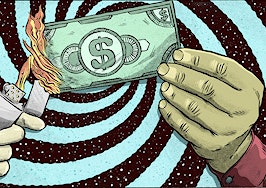It’s been 12 years since we stood on the precipice of the Great Recession. Despite the strong economy and high demand, there are signs a market downturn may be on the horizon. Are we currently experiencing the calm before the storm as we were in 2006?
The early 1980s downturn
I’ve experienced three major downturns over the course of my career. When I first started in the business, interest rates were at 9.75 percent fixed. The market remained strong until the rates hit 13 percent in early 1981. At that point, it came to a grinding halt as rates shot as high as 18 percent later that year.
Things were so bad that our entire office was thrilled when Home Savings and Loan announced a fantastic 30-year fixed rate of 16.75 percent.
The savings and loan crisis of the 1990s
The downturn of the 1990s was also correlated with an increase in interest rates. This chart shows an uptick in rates from a low of about 9 percent in January 1987 to 12 percent in the early 1990s.
This coincided with the second downturn, which many people attribute to the savings and loan crisis of the 1990s.
The Great Recession
The Great Recession showed signs of rearing its ugly head in early 2006 and was, without a doubt, the worst crash of our lifetimes. Two primary triggers were zero-down loans and “no” or “easy-qualifier” loans that didn’t require proof of income.
This resulted in people purchasing houses they couldn’t afford. Those who did have equity, treated their homes as their personal piggy banks by refinancing repeatedly.
When prices dropped by as much as 60 percent in the hardest hit areas, foreclosures and short sales exploded as millions lost their homes or were forced into a short sale.
Zero-down loans are still alive and well
According to Bankrate.com, there are at least five sources for zero down payment loans today.
Those resources include some FHA and VA programs, the USDA Home Loan Program, plus certain down payment assistance and grant programs.
Reading the tea leaves in 2018
Despite the high demand, we have many of the same elements that contributed to the previous downturns: increasing interest rates, zero-down loans and what appears to be a slowing market with increasing inventory.
Here are just a few of the takeaways from multiple news sources’ headlines in the past few weeks that bear out this concern:
From CNBC Realty Check’s article, “Housing demand sees biggest drop in more than 2 years“:
- Housing demand fell 9.6 percent in June, compared with June 2017, according to a monthly index from Redfin. That is the largest decline since April 2016.
- The number of people requesting home tours fell 6.1 percent annually in June.
- While supply declined overall, Redfin noted a large increase in listings in some of the most supply-starved markets, which is where home prices have overheated most.
Also from CNBC Realty Check: “Housing market is showing signs of cracking: ‘Anything goes list-price strategy is no longer working’“:
- Even in the hottest markets, there is an affordability limit, and that limit is clearly now being hit.
- “We’re still selling most every home, but now it is usually with just one or two offers over the 10 to 15 offers we were seeing earlier in the year,” said David Fogg, a real estate agent based in Burbank, California.
From Bloomberg Real Estate came the article, “The US housing market looks heading for its worst slowdown in years,” which noted:
The U.S. housing market — particularly in cutthroat areas like Seattle, Silicon Valley and Austin, Texas — appears to be headed for the broadest slowdown in years. Buyers are getting squeezed by rising mortgage rates and by prices climbing about twice as fast as incomes, and there’s only so far they can stretch.
“This could be the very beginning of a turning point,” said Robert Shiller, a Nobel Prize-winning economist who is famed for warning of the dot-com and housing bubbles, in an interview. He stressed that he isn’t ready to make that call yet.
As CNBC’s Realty Check reported, rising interest rates are impacting affordability. With each interest rate increase, the buyer pool shrinks. This lessens demand and can eventually produce plunging prices.
What the artificial intelligence (AI) says
Allan Weiss, the CEO of Weiss Analytics and former CEO of Case-Shiller Weiss, provided Inman with access to the heat maps his company produces to assist buyers, sellers and their agents in correctly pricing their properties. The heat maps are a powerful predictor of what’s ahead in local markets.
The screen shots show how prices change. Dark green is a strong seller’s market with price appreciation, light grayish green or red is a transitioning or flat market with steady prices and dark red is a buyer’s market with price depreciation.
This first screen shot is for July 2008. It shows the West Los Angeles market at the height of the crash. Everything is in red and is decreasing in price.

The next map shows the same market in 2013 when prices were rising drastically.

As a rule of thumb, price decreases lag behind inventory increases somewhere between 6-18 months based upon the market.
Looking back at that time, we know that in July 2006, the downward price spiral was just beginning. The map below shows a transitional market, with a few red areas just starting to show. At that point, inventories had been increasing since late 2005.

While the July 2018 map doesn’t show any red (yet), the green parts have virtually disappeared, indicating a market with no price appreciation.
Given that Southern California’s Westside has been one of the hottest markets in the country, this represents a drastic shift from a seller’s market to what could possibly be the next buyer’s market with price depreciation.

Is this the beginning of the next buyer’s market?
All real estate is ultimately local. With many experts predicting two more interest rate hikes before the end of the year, decreased affordability will continue to drive down demand.
It’s also important to note that you can have a strong seller’s market and a horrific buyer’s market in the same ZIP code.
Consequently, the most important statistic you can track is the number of months of inventory on the market by price and location. If the inventory is creeping near the six-month level, you’re approaching a balanced market.
If the inventory increases to eight months of supply or more, look out — you’re in a buyer’s market and prices will soon be dropping.
Take immediate action to get your sellers to lower their prices and get their properties sold. Also, don’t forget to dust off those old buyer prospecting skills — there’s a good chance you will need them.
Bernice Ross, President and CEO of BrokerageUP (brokerageup.com) and RealEstateCoach.com, is a national speaker, author and trainer with over 1,000 published articles. Learn about her broker/manager training programs designed for women, by women, at BrokerageUp.com and her new agent sales training at RealEstateCoach.com/newagent.













